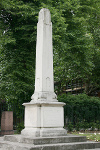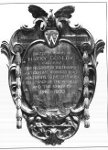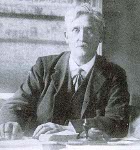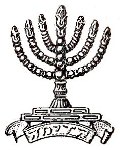

War
Memorial (1924) & Armisticetide
observance
 The
parish magazine for December
1923
explained why progress on erecting a memorial had been delayed.
Congregational finances and numbers were at a low ebb, and all their
energy had gone into essential repairs to the church building,
including the installation of electric lighting. This had cost £750,
and was made possible in part by the sale of some historic silver - see here
for details. This
meant that raising funds for a memorial had been put on hold.
Furthermore, Mr Joseph Clayton, architect and war veteran who had
been a member of the congregation and had given a lead on this
project, had moved to the Midlands, and the churchwardens were still
hoping that he would return!
The
parish magazine for December
1923
explained why progress on erecting a memorial had been delayed.
Congregational finances and numbers were at a low ebb, and all their
energy had gone into essential repairs to the church building,
including the installation of electric lighting. This had cost £750,
and was made possible in part by the sale of some historic silver - see here
for details. This
meant that raising funds for a memorial had been put on hold.
Furthermore, Mr Joseph Clayton, architect and war veteran who had
been a member of the congregation and had given a lead on this
project, had moved to the Midlands, and the churchwardens were still
hoping that he would return!
Armistice
Day 1923 fell on a Sunday, and the congregation kept two minutes'
silence, as desired by the King.
In March 1924
the magazine reported that there had been discussion with the Tower
Hamlets (South) Ex-Service Men's Club and the Highway Clubs, and
the Mayor of Stepney had promised support, and had informed
council committees of the plans. The fund stood at £75 10s
8d.
 Three
possible
sites were under discussion:
Three
possible
sites were under discussion:
 In
June 1924
the fund stood at £210. The Member of Parliament and the other
parliamentary candidates [see notes below] were involved; local schools
and firms had subscribed, as had the Mercers and Drapers [wealthy City
livery companies], the Mayor, Lord Winterton and Sir
Edward Mann
(1854-1953, first Mayor of Stepney 1900-02 and first Baron Mann of
Thelveton Hall 1905, chairman of Whitechapel brewers Mann, Crossman and
Paulin Ltd. (whose Albion Brewery at 172 Whitechapel Road depicted their logo of St George slaying the dragon) - painting right, by George Boucas, at the Bancroft Library).
In
June 1924
the fund stood at £210. The Member of Parliament and the other
parliamentary candidates [see notes below] were involved; local schools
and firms had subscribed, as had the Mercers and Drapers [wealthy City
livery companies], the Mayor, Lord Winterton and Sir
Edward Mann
(1854-1953, first Mayor of Stepney 1900-02 and first Baron Mann of
Thelveton Hall 1905, chairman of Whitechapel brewers Mann, Crossman and
Paulin Ltd. (whose Albion Brewery at 172 Whitechapel Road depicted their logo of St George slaying the dragon) - painting right, by George Boucas, at the Bancroft Library).
|
UNVEILING
OF THE ST. GEORGE'S-IN-THE-EAST WAR MEMORIAL
Saturday, November 15th, 1924, at 3.30 p.m. After a week of rain, in which it seemed well night impossible that the monument could be erected in time, Saturday turned out perfectly dry: all the anxious arrangements which had been made in case of rain proved unnecessary, greatly to the relief of those who made them. The church bells were rung half muffled from 2.0 to 3.0 p.m. Earl Winterton [1] was practically the first to arrive at the Town Hall, well before three o'clock. To our great disappointment he had to break it to us that Lady Winterton [1] was confined to bed with a very bad cold, and had not been able to come up from the country. Bandmaster W. Hussey, of the 53rd Brigade (Territorial) Royal Artillery came next and relieved us of any fear that the Band might be late. The Marshall, Mr. Stanley Degerlund, and his assistant, Mr Jack Warncken, were soon busy marshalling their procession. This was led by Mr Dunkley (late R.F.A.) and consisted of a fine muster of ex-Service men, nurses, St. John's Ambulance men, Girl Guides, Rangers and Brownies, Boy Scouts, Rovers and Cubs [2], and the Church Choir, Messrs. Judd, Degerlund Senior, Sidesmen, Clergy from St Paul's, Shadwell; St. John, at Wapping; St. Peter's, London Docks; St. John's, Grove Street; The Ebenezer Chapel; The Seamen's Friends' Mission [now the Strangers' Rest Mission, 131 The Highway]; and the Parish Church [3]. Then followed those who were to perform the ceremony, Earl Winterton accompanied by Mr. Harry Gosling, M.P.[4], and His Worship the Mayor, supported by his Mace-bearer, the Town Clerk and a number of Aldermen, Councillors and their ladies. The attendance of relatives and friends of the fallen, subscribers to the Memorial, and residents was very large and far in excess of what was expected. It was in consequence quite difficult for the procession to move round the Memorial and take up their allotted positions on three sides of it, leaving the fourth to the relatives of the fallen, who thus had an unimpeded view of the front of the monument and of the unveiling. Among the large crowd could be observed Mr. William Martineau, lately Conservative candidate [5], and Major Nathan, lately Liberal candidate [5], the Head Master of Cable Street Central School, and the Heads of three departments at Highway School. As soon as the Mayor had reached this place the Rector read a well-known prayer for the fallen and another for their bereaved relatives: Earl Winterton, in a kind and sympathetic speech, expressed his satisfaction that the names of the men from this area which fills so large a place in his heart should be suitably immortalised and that as men of all creeds had united to defend the country, their names should appear together on one monument. He then pulled what certainly seemed to be the right cord to release the Union Jack with which the monument was veiled. Through a curious mistake of the man who did the veiling, the releasing cord was invisible to Lord Winterton and the one he pulled only tightened the knot. The Marshall, Mr. Stanley Degerlund, noticed the trouble, and succeeded in releasing the flag which fell as intended, and which he removed to make room for the expected wreaths. The hymn O God our help in ages past was then sung. The Bishop of Stepney then dedicated the Memorial. The Rev. J.F. Stern, minister of the Stepney Green Synagogue, then read the first nine verses of the third chapter of the Book of Wisdom, commencing But the souls of the righteous are in the hands of God.... It will be remembered that Mr. Stern lost his only son Leonard, a brilliant student, at the Front [6]. Captain B.L.Q. Henriques, J.P., warden of The Oxford & St. George's Jewish Settlement situated in this parish [6], then invited the Mayor and Corporation to accept the care and preservation and guardianship of the Memorial. He spoke with great feeling and eloquence of the significance of the monument. His voice was heard all over the ground, and all present are unanimous in saying that his speech was as apt as it was beautiful. Readers are no doubt familiar with Captain Henriques's war record, the stimulus he gave to 'join up' among his wide acquaintance of young men, his fine leadership in France, his taking the first tank into action on the Somme and his being wounded. He also lost a brother killed in action. His Worship the Mayor then expressed on behalf of the Borough their cordial acceptance of the trust to care for and preserve the Memorial. Then were sung three verses of Mr. Arkwright's wonderful hymn, now used everywhere on Armistice Day and on these occasions, beginning O Valiant hearts [7]. During the singing all who desired to do so laid flowers on the memorial, and those present soon learned whether people of St. George's have forgotten their beloved heroes! The procession began with Chris Giles representing the War Orphans and Miss Lavinia Botterill [8] representing the generation which is passing away, and it went on and on and on! The hymn had to be sung all over again and still they came! At last the whole base of the monument was deep in lovely flowers, mostly white, and in the grey November dusk the tall yellow monoleth [sic], a very fine piece of Portland stone, rose out of its flowery bed almost like a symbol and vision of those in whose memory it had been raised. The Bishop gave the Benediction, the trumpeters sounded the Last Post and the Reveille: the band played God Save the King and the procession moved back to the Town Hall. The Mayor provided tea for the Councillors and their ladies and others in the Town Hall and the Committee entertained the relatives of the fallen in the Mission Hall. It was hoped the constables on duty would come in for a cup of tea, but they had gone before the invitation could be conveyed to them. We desire to tender our very heartiest thanks to all the many kind people who helped to get a War Memorial for St. George's and to get it unveiled in a suitable manner. The list is too long for enumeration, so we will content ourselves with mentioning Miss C.J. Skelton, the Honorary Secretary of the Committee, who, simply as a labour of love to the men who fell in the war, has toiled unremittingly for practically a year to make the enterprise a success. Without her it would have remained merely an idea and would never have been converted into a beautiful and enduring thing. |

 [4] Harry Gosling (1861-1930) had been
elected as Labour MP for Stepney, Whitechapel & St George's on 5
December 1923, and in what became a hung parliament served as Labour's
first Minister of Transport from January to November 1924, and also as
Paymaster General from May to November 1924, in Ramsey MacDonald's
government. As President of the
National Transport Workers Federation he had played a leading part in
the 1910 Dock strike. He was re-elected on 29 October 1924, and served
until his death in 1930; he was made a Companion of Honour, and Harry
Gosling School, in the parish, perpetuates his name, as does Gosling
House (Sutton Street) and Gosling Gardens (Bigland Street). [Left - memorial plaque in Transport House,
Westminster.] He wrote his memoirs as Up and Down Stream (Methuen 1927).
[4] Harry Gosling (1861-1930) had been
elected as Labour MP for Stepney, Whitechapel & St George's on 5
December 1923, and in what became a hung parliament served as Labour's
first Minister of Transport from January to November 1924, and also as
Paymaster General from May to November 1924, in Ramsey MacDonald's
government. As President of the
National Transport Workers Federation he had played a leading part in
the 1910 Dock strike. He was re-elected on 29 October 1924, and served
until his death in 1930; he was made a Companion of Honour, and Harry
Gosling School, in the parish, perpetuates his name, as does Gosling
House (Sutton Street) and Gosling Gardens (Bigland Street). [Left - memorial plaque in Transport House,
Westminster.] He wrote his memoirs as Up and Down Stream (Methuen 1927).
 [6]
It is noteworthy that the Rector invited representatives, not only of
other Christian denominations (as was usual for such an event), but of
other faiths (much less common, though given the significant number of
Jewish servicemen listed on the memorial, this was, of course, entirely
appropriate: see here and here for details about the Jewish Legion formally raised in 1917, but active for two years previously - cap badge left, veterans' ribbon right).
[6]
It is noteworthy that the Rector invited representatives, not only of
other Christian denominations (as was usual for such an event), but of
other faiths (much less common, though given the significant number of
Jewish servicemen listed on the memorial, this was, of course, entirely
appropriate: see here and here for details about the Jewish Legion formally raised in 1917, but active for two years previously - cap badge left, veterans' ribbon right). 
 (b) Joseph Frederick Stern, later CBE (1865-1934) [left - note his clerical collar] was
appointed Preacher, Reader and Secretary of the East London United
Synagogue, Rectory Square, Stepney Green [right]
in 1887, and took full charge
after the removal of his predecessor Victor Rosenstein after a series
of scandals, serving until 1928. Sometimes dubbed the 'Jewish Bishop of
Stepney' for his social
work, he modernised the liturgy, introduced children's services, a
mixed voluntary choir (under Bernard Cousins) and an 8' mahogany
pulpit, and offered cheap marriage
ceremonies. He is said to have chanted the prayers, in Hebrew and
English, in a manner akin to Anglican clergy, and with a marked English
accent! (The shammas (sexton) was the formidable Mr Kloot who, it is
said, only had to raise a finger to silence those talking during
service - his son Len ran the 7th Stepney Scout troop). From 1902 he
was a member of the founding committee of the Jewish Religious Union,
forerunner of the Liberal Jewish movement. As mentioned above, his son
Leonard was killed in the First World War; he was club manager of
Henriques' boys club (the ner tamid - perpetual light - hanging before the Ark in the Settlement Synagogue was dedicated in his memory.)
(b) Joseph Frederick Stern, later CBE (1865-1934) [left - note his clerical collar] was
appointed Preacher, Reader and Secretary of the East London United
Synagogue, Rectory Square, Stepney Green [right]
in 1887, and took full charge
after the removal of his predecessor Victor Rosenstein after a series
of scandals, serving until 1928. Sometimes dubbed the 'Jewish Bishop of
Stepney' for his social
work, he modernised the liturgy, introduced children's services, a
mixed voluntary choir (under Bernard Cousins) and an 8' mahogany
pulpit, and offered cheap marriage
ceremonies. He is said to have chanted the prayers, in Hebrew and
English, in a manner akin to Anglican clergy, and with a marked English
accent! (The shammas (sexton) was the formidable Mr Kloot who, it is
said, only had to raise a finger to silence those talking during
service - his son Len ran the 7th Stepney Scout troop). From 1902 he
was a member of the founding committee of the Jewish Religious Union,
forerunner of the Liberal Jewish movement. As mentioned above, his son
Leonard was killed in the First World War; he was club manager of
Henriques' boys club (the ner tamid - perpetual light - hanging before the Ark in the Settlement Synagogue was dedicated in his memory.) | Mr Stern would defy the foreign prejudice and carry and umbrella (on the Sabbath) if he needed one, but not a walking stick ... Mr Stern preached on the preceding Sabbath on Gladstone's death. The congregation accepted it. In a chevra they would have said 'who is this William Ewart Gladstone?' Mr Stern would like to go further than he is free to do so. He breaks the din [Jewish law] every day (according to the Interviewer) but has to be wary of offending the foreigner. He would abandon the annual cycle (of Sabbath readings from the Pentateuch, presumably in favour of the triennial cycle); use more English in the Service. He objects to Zionism and praying for the restoration of sacrifices ... although thought a little too much of an innovator by one, he is much respected and his energy and devotion are very great. On the whole, he is a good specimen of the Jew, full of his religion and filled with loyal English sympathies. |
| Give thanks to God O
England for thy Sons To the Glorious Memory of the Brave Men from St George-in-the-East who laid down their lives in the Great War 1914 - 1918 [later addition - no names were added] and those who died in World War II 1939-1945 |
||||
| ADAMS C ALCOCK J ANGLER C AMNERS G ASKEW H BAGGS J W BALDOCK W BRINLEY G BRINSTOCK M BIRD R BORCHARD G C BOWLES C BOWLES J BRIAN D BUCKTHORN A BUNLING C CAMINER A CARSON J CLAPTON H CLARK A |
COBB W COBLEY H COLEMAN W COMMONS H CORRIE G COTTON H CUTHBERT W H DAVIES A DEAL J T DENBY J DENNIS C DENNIS J DONOVAN J P DUNDRON J FISHER T E FITCHEM H GARDNER A GATES A S GILES C GOLDSTEIN A |
GOLIGHTLY
W HALL G W HARRIS T HOBBINS W INGHAM W JACQUES W JONES E KALMINSKY J KEIL J KENNEDY P KERWICK W T KING J KNOTT J KOHLE V LEWIS D McCARTHY M MADSEN W MADLIN - Sgt MARSH W MILLER E |
MILLER
R MILLER W MORRELL F MORRIS F MORTIMER R E MYERS - NEWBOLT - PATSE - PERCY - PITCHER - PITCHER - RIVERS R S ROBERTS V H ROPTEY - ROPTEY T F ROSSNBERG D SHAPIRO S SLATTERY J SMITH A H Lt SPEARING S |
STANDER
D STEVENS I SULLIVAN M STRETT - TAYLOR J THURSTON E THURSTON - WINGENT - WALLIS - WEMERTON - WILLSON - WILKINSON - YOUNG - WALTERS - WATKINS - WILLIAMS R L |
In
the years that followed, observance was kept both on the nearest Sunday
and on 11 November (a pattern that has re-emerged in recent years). For a few years, there were three observances: one
before the Sunday morning service, with servicemen's organisations in
attendance; one after, for the congregation; and one on Armistice Day
itself - when the two minutes' silence was observed. In the 1925 magazine the Rector
reported
|
At the request of some of the local lodges of the R.A.O.B. [Royal Antedeluvian Order of Buffaloes - a kind of working-class Freemasonry] a special Service of Remembrance was held at the War Memorial on Armistice Sunday. It was the third of such annual services arranged by the Order, but the first to be held at St. George's, and whereas two years ago only a little group of fifteen members from one lodge attended, this year seven lodges took part and were represented by ninety members. The Brethren assembled in their regalia at the foot of the Church steps at 10.45 and then, headed by the Choir, Churchwardens, Sidesmen and the Rector, and followed by members of the St. John's Ambulance Association, and the St. George's Scouts and Guides, proceeded to the War Memorial singing the hymn O God, our help in ages past. At the Memorial a short service was held and another hymn sung, and the various lodges placed memorial wreaths at the foot of the pedestal. On their return, the Rector gave the blessing from the Church steps. The Lodges represented were the Peabody Lodge, Mercantile Lodge, Commercial Lodge, Sir A.E. Hodgson Lodge, Stepney Lodge, Chas. A. Hill Lodge, and the William Faulkner Lodge. All the arrangements for the service were made by Bro. H.C. Kleyweg, C.P. Our own Church services throughout the Sunday were better attended than they often are ... A special Service of Remembrance was held after the Church service in the morning, and though the day was one of high winds and driving rain a large number of the congregation went out to the War Memorial and there joined in hymns and prayer. Yet another visit was made to the Memorial on Armistice Day itself. No service had been announced for the middle of the morning, as it was thought unlikely that people could get off from work to attend it, but the Church was open and a good number came in, so we had a short service after all, and then went out to spend the time of silence round the Memorial ... There seems to have been a new spirit in the observance of Armisticetide this year which justifies the hope that the appeal [by the Archbishops of Canterbury and York, together with the President of the Council of the Free Churches] will not fall on deaf ears. The most striking evidence of the new spirit was probably to be found in the Albert Hall on Armistice Day. A great Charity Ball was to have been held that night, and the Hall was all decorated for it. But it had become clear that a good many felt the Ball would be unfitting on such a night, and it was postponed; and in its place a service was held which drew such crowds that thousands had to be turned away... |
In
the following year (1926), the Rector reported that Armistice
Day remained popular - there were big events at the Cenotaph, and
crowds in Trafalgar Square and Oxford Circus; the local service
included lodges, nurses from St
George's Hospital, the British Legion (from Tait St Hall, formerly a parish mission room),
buglers from Jewish Lads' Brigade, and our own scouts, guides and
brownies. And there were even more taking part in 1927, when he wrote It is unfortunate that down here it seems
impossible to get complete silence, no doubt because it is difficult
for people to get their clocks absolutely right. So our silence was
broken this time by the passing of a train, the sounding of a syren
[sic] on the river, and the
ringing of a bell in a neighbouring
school.
By 1928, a pattern was emerging, with Sunday services as usual, but all with a special character (including reading the names of the fallen in church), and collections for the St Dunstans' charity working with blinded soldiers (now Blind Veterans UK); parish groups laid wreaths of Flanders poppies at the memorial. On Armistice Day, a brief service at 10.30am preceded the two minutes' silence at the memorial.
In 1933 the name 'Remembrance
Sunday' was introduced nationally, and in this parish as elsewhere the
collection was taken for the Earl Haig Fund [now generally known as the 'Poppy Appeal']. When 11 November fell
on a Sunday (as in 1934), the morning service began early so that the
silence could be kept at the memorial at 11am.
Back to Church & Churchyard